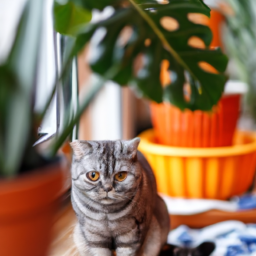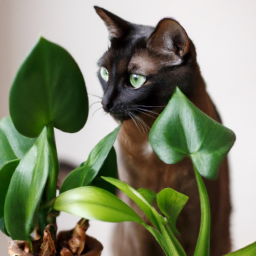
Are you a proud cat owner who also loves to have indoor plants in your home? If so, you might be concerned about the potential dangers that some plants can pose to your feline friend. But fear not! In this blog post, we will explore a variety of indoor plants that are not toxic to cats, allowing you to create a beautiful and safe environment for both you and your beloved pet. So, let’s dive in and discover some pet-friendly greenery options that will bring life and freshness to your home without compromising your cat’s well-being.
Top 10 Indoor Plants Safe for Cats: A Comprehensive Guide
Hello there, fellow cat lovers! Are you looking to spruce up your indoor space with some beautiful greenery, but worried about the safety of your feline friend? Look no further! In this comprehensive guide, we will explore the top 10 indoor plants that are safe for cats. With these plants, you can create a cat-friendly environment while adding a touch of nature to your home. Let’s dive in and discover some purrfect options!
1. Spider Plant (Chlorophytum comosum)
The Spider Plant is a popular choice among cat owners due to its non-toxic nature. Not only does it add a touch of elegance to any room, but it also helps in purifying the air. This plant features long, arching leaves with white stripes, giving it a unique and eye-catching appearance.
Spider Plants are relatively easy to care for and can thrive in a variety of lighting conditions, making them a versatile choice for any indoor space. They are known to be safe for cats, even if they decide to take a nibble. However, it’s always a good idea to discourage your cats from chewing on plants to avoid any potential digestive issues.
If you have a curious cat who loves to play with dangling objects, the Spider Plant can provide some entertainment. The plant produces small plantlets that dangle from the mother plant, resembling tiny spiders. This can be a fun and interactive element for your feline companion!
2. Boston Fern (Nephrolepis exaltata)
The Boston Fern is not only a beautiful addition to your indoor space but also a safe choice for your furry friends. Its lush green fronds add a touch of elegance and bring a sense of tranquility to any room.
When it comes to caring for a Boston Fern, it’s important to keep the soil consistently moist and provide it with indirect sunlight. This plant thrives in humid environments, making it ideal for bathrooms or kitchens where moisture levels are naturally higher.
While the Boston Fern is non-toxic to cats, it’s worth mentioning that the fronds can be tempting for some curious kitties. If you notice your cat showing too much interest in the plant, you can try hanging it from the ceiling or placing it in an area that is less accessible to your feline friend.
3. Areca Palm (Dypsis lutescens)
The Areca Palm, also known as the Butterfly Palm, is a beautiful and pet-friendly plant that can add a tropical vibe to your home. With its feathery, arching fronds, it creates a stunning visual impact and helps in purifying the air by removing toxins.
When it comes to caring for an Areca Palm, it’s important to provide it with bright, indirect light and water it regularly. This plant thrives in well-draining soil, so make sure not to overwater it.
While the Areca Palm is generally safe for cats, it’s always a good idea to monitor your feline friend’s behavior around the plant. Some cats may be attracted to the fronds and may try to chew on them. If you notice any excessive interest, it’s best to discourage the behavior to prevent any potential issues.
In Conclusion
Creating a cat-friendly indoor space doesn’t mean you have to compromise on the beauty of your plants. By choosing the right indoor plants that are safe for cats, you can have the best of both worlds. Remember to always research any new plants you bring into your home and keep an eye on your furry friend’s behavior around them. With proper care and attention, you can enjoy a harmonious environment where your cat and plants can coexist happily. Happy gardening!


The Benefits of Indoor Plants for Cats: Safe and Stimulating Environment
Introduction
Indoor plants not only add beauty and freshness to our homes but can also provide numerous benefits for our feline friends. Cats are curious creatures, and having plants indoors can create a safe and stimulating environment for them to explore. In this article, we will delve into the advantages of indoor plants for cats, highlighting the plants that are safe for them and how they can enhance their overall well-being.
Creating a Safe Haven
Indoor plants offer a natural and safe haven for cats, allowing them to fulfill their innate desire to be surrounded by greenery. These plants provide a sense of security and tranquility for our furry companions, making them feel more at ease in their environment. Additionally, plants can act as a barrier, preventing cats from accessing potentially hazardous areas or objects in the house.
When selecting indoor plants, it is crucial to choose ones that are non-toxic to cats. Some common plants that are safe for cats include spider plants (Chlorophytum comosum), Boston ferns (Nephrolepis exaltata), and African violets (Saintpaulia ionantha). These plants not only add visual appeal to your home but also ensure the well-being of your feline companion.
Improving Air Quality
Indoor air quality is a significant concern for both humans and animals. Plants play a vital role in purifying the air by removing harmful toxins and releasing oxygen. This is especially beneficial for cats, as they are more sensitive to airborne pollutants due to their smaller lung capacity. By having indoor plants, you can create a healthier living space for your cat, reducing the risk of respiratory issues and allergies.
Some plants known for their air-purifying properties include the snake plant (Sansevieria trifasciata), bamboo palm (Chamaedorea seifrizii), and peace lily (Spathiphyllum spp.). These plants not only enhance the aesthetics of your home but also contribute to a cleaner and fresher environment for your feline companion.
Stimulation and Enrichment
Indoor plants provide cats with a source of mental and physical stimulation, which is essential for their overall well-being. Cats are natural hunters, and having plants indoors can mimic their instinctual desire to explore and engage in play. Plants with dangling leaves or vines can serve as interactive toys for cats, encouraging them to jump, pounce, and swat.
In addition to physical stimulation, plants also offer cats an opportunity to engage their senses. The different textures, scents, and colors of plants can captivate their attention and provide sensory enrichment. This can help alleviate boredom and prevent behavioral issues caused by a lack of mental stimulation.
It is important to note that while plants can provide stimulation for cats, it is essential to choose ones that are safe and non-toxic. Some plants that are both stimulating and safe for cats include catnip (Nepeta cataria), cat grass (Dactylis glomerata), and silver vine (Actinidia polygama).
Conclusion
Indoor plants not only beautify our homes but also offer numerous benefits for our feline companions. They create a safe and stimulating environment, improve air quality, and provide mental and physical enrichment for cats. However, it is crucial to choose plants that are non-toxic to cats to ensure their safety. By incorporating indoor plants into our homes, we can create a harmonious and enjoyable space for both ourselves and our beloved furry friends.
Here’s what we learned
If you’re a cat lover and a plant enthusiast, it can be a challenge to find indoor plants that won’t harm your feline friends. Cats are notorious for nibbling on anything green, and unfortunately, many common houseplants are toxic to them. But fear not! There are plenty of beautiful and safe indoor plants that you can enjoy without worrying about your furry companion’s well-being.
One great option is the Spider Plant (Chlorophytum comosum). Not only is it non-toxic to cats, but it’s also a breeze to care for. With its long, arching leaves and small white flowers, this plant adds a touch of elegance to any room. Another cat-friendly choice is the Boston Fern (Nephrolepis exaltata). With its lush, feathery fronds, it brings a refreshing burst of green to your space while being completely safe for your curious kitty. Just be sure to place it in a spot with indirect sunlight to keep it happy and healthy. So, don’t fret! You can still create a green oasis in your home, knowing that your beloved cat can roam freely without any harm from these delightful indoor plants.
FAQ Roundup:
Q1: What are some indoor plants that are not toxic to cats?
A1: There are several indoor plants that are safe for cats. Some popular options include spider plants, Boston ferns, areca palms, money plants, and African violets. These plants are non-toxic to cats, meaning they won’t cause harm if your furry friend decides to take a nibble.
Q2: How can I ensure my indoor plants are safe for my cat?
A2: To ensure your indoor plants are safe for your cat, it’s important to do some research before bringing any new plants into your home. Look for plants that are labeled as non-toxic to cats or consult a list of cat-friendly plants. Additionally, consider placing your plants in areas that are out of your cat’s reach or using deterrents like bitter sprays to discourage them from chewing on the plants.
Q3: What are the signs of plant poisoning in cats?
A3: If your cat has ingested a toxic plant, they may exhibit various signs of plant poisoning. These can include vomiting, diarrhea, drooling, difficulty breathing, lethargy, loss of appetite, and even more severe symptoms. If you suspect your cat has been poisoned by a plant, it’s crucial to contact your veterinarian immediately for guidance and assistance.
Q4: Are there any common indoor plants that are toxic to cats?
A4: Yes, there are several common indoor plants that are toxic to cats. Some examples include lilies, pothos, peace lilies, snake plants, and philodendrons. These plants contain substances that can be harmful or even fatal to cats if ingested. It’s best to avoid having these plants in your home if you have a curious feline companion.
Q5: Can I still have toxic plants if I keep them out of my cat’s reach?
A5: While keeping toxic plants out of your cat’s reach can reduce the risk of ingestion, it’s not a foolproof solution. Cats are agile and curious creatures, and they may find a way to access plants that are placed high up or in hanging baskets. It’s always safer to opt for non-toxic plants to ensure the well-being of your furry friend and provide them with a cat-friendly environment.
Dr. Olivia Green is a botanist with over two decades of experience in indoor plant cultivation. She holds a Ph.D. in Plant Biology and has dedicated her career to researching plant behavior in controlled environments. Dr. Green is passionate about helping plant enthusiasts master the art of indoor gardening through her extensive knowledge and practical insights.


